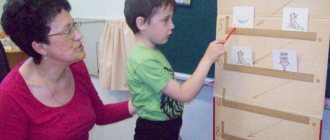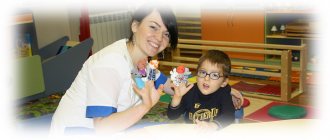Tachylalia, or accelerated speech rate, is a neuropsychiatric disorder and often manifests itself against the background of a primary disease - nervous or mental. A speech disorder is accompanied by repetitions of words, “swallowing” of endings, hesitations, and incorrect pronunciation of words or syllables. Children who are excitable, hyperactive, or diagnosed with ADHD (attention deficit hyperactivity disorder) are especially susceptible to it.
Therefore, the diagnosis and treatment of tachylalia is approached comprehensively. It is necessary, first of all, to identify and eliminate the cause of the disease - this is the only way to achieve good results. Otherwise, the disease can remain with the person for life and create many difficulties.
Classification of speech impairment by type of tachylalia
Normally, a person speaks 10 - 12 sounds per second, with an accelerated rate of speech - up to 30.
There are 3 forms:
- Clean . The child speaks at an accelerated pace, but without grammatical, phonetic, or lexical errors;
- Battarism , or paraphasia. The child “chokes” and cannot finish the sentence he has started. This occurs due to impaired speech breathing. In some cases, children construct lexical constructions incorrectly;
- Poltern , or stumbling. In this case, there are too many hesitations and pauses in the child’s speech, he cannot find the right words, repeats words or syllables that have already been spoken, and it is difficult for him to express his thoughts.
In addition, there are several types of polternes with different disorders: motor (in this case, the child not only speaks quickly, but also pronounces sounds incorrectly), sensory (auditory attention is impaired), with difficulties in selecting words and formulating speech.
Examination of children with violations of the tempo and rhythm of speech
If parents suspect that their child has disturbances in the tempo and rhythm of speech, they should consult with a speech therapist at a children's clinic, speech center, school or kindergarten. Sometimes you can hear the erroneous opinion that you should not start correcting speech deficiencies until the child is 5 years old.
This is partly true for uncomplicated cases of sound pronunciation formation, since the speech apparatus has not yet been formed, and sounds can appear on their own. In all other cases, the sooner correction work begins, the more successful it will be.
At the initial visit, the specialist is required to conduct a speech therapy examination. The main directions of this survey:
- Establishing the cause and nature of speech impairment.
- Determining the rate of speech of the child and his parents.
- Diagnosis of basic mental processes (memory, attention, thinking).
- Studying the history of speech development - the appearance of the first words, phrases, the likelihood of parents forcing the child’s speech. Bilingualism in the family.
- Determining the style of family education, attitude towards the child, the presence of conflicts, difficult life situations.
- Collecting anamnesis of the disorder and concomitant pathologies.
- Determination of existing articulation deficiencies.
- Correspondence of the level of speech development of the child to the age norm.
Perhaps some questions may seem unnecessary to parents, but the speech therapist does not ask them out of idle curiosity - there are no trifles in the development and correction of speech disorders, the situation in the family and the presence of psychological problems are very important.
Causes of speech disorders
The causes and mechanisms of tachylalia are based on psychogenic and somatic factors, as well as habit. At risk are children with an unbalanced psyche, hyperactive, and easily excitable.
If one of your immediate blood relatives is diagnosed with tachylalia, the risk of developing it in your child increases.
The development of the disease can be triggered by a brain tumor, traumatic brain injury, neuroinfection or mental disorder - schizophrenia, for example.
A social factor cannot be excluded - mistakes in raising a child, when he is encouraged to imitate the fast speech of adults.
Reasons for the development of tachylalia
In speech therapy practice, the causes of tachylalia are different, and there are many opinions, among which the following theories about the causes of the development of tachylalia are distinguished:
- genetic predisposition;
- imitation on the part of the child of the fast pace of speech of others;
- improper speech education.
Most often, unbalanced, hyperactive children with increased excitability are susceptible to tachylalia. At the same time, the manifestation of speech disorders in childhood can worsen in adolescence and accompany a person throughout his life.
Sometimes tachylalia develops against the background of the growth of brain tumors or against the background of other brain pathologies (TBI, neuroinfections, epilepsy). Also, the causes of tachylalia can be various psychiatric pathologies: this is the development of schizophrenia, manic-depressive psychosis, etc.
By the nature of its development, tachylalia is a certain process of dominance of excitation over inhibition, which entails a violation of the tempo of internal and external speech.
Symptoms of tachylalia in children
The most characteristic symptoms can be divided into several groups:
1. Features of speech. She is very fast and inarticulate, making her extremely difficult to understand. It is dominated by repetitions, “swallowing” of endings, and rearrangement of syllables;
2. Reading and writing skills. Patients with tachylalia have difficulty in this area;
3. Features of general motor skills. The movements are rapid, nervous, the child is fussing;
4. Problems with attention and memory. The child quickly switches attention, cannot concentrate on one thing, has poor memory;
5. Reactions of the autonomic nervous system. If a child is excited, his face turns red, his heart rate increases, and he sweats.
These symptoms are a reason to show the child to a neurologist.
Comprehensive diagnosis of the disease
Several specialists take part in the diagnosis of the disease - a neurologist, a psychiatrist, a speech therapist.
A neurologist assesses the neurological status of a small patient, and a psychiatrist identifies mental abnormalities.
Before a child is diagnosed, extensive testing is performed to determine organic causes of tachylalia. For this use:
- Hardware diagnostics - MRI of the brain, electroencephalography (EEG), echoencephalography (Echo-EG);
- Diagnostics of speech - oral, written.
Based on the data obtained during the diagnosis, the little patient is diagnosed and prescribed a treatment regimen.
An integrated approach to treatment
Correction of tachylalia is also approached in a comprehensive manner. Here are the areas in which doctors work:
- Medical impact. This group includes: drug therapy, exercise therapy, massage;
- Psychotherapy. Body-oriented therapy and art therapy are considered the most effective;
- Speech therapy correction of tachylalia. Group classes give the best results.
Only a combination of the listed approaches gives positive dynamics. Next, we will consider the techniques that are used to correct tachylalia in children.
Breathing gymnastics: a set of exercises
It is important to count when doing exercises. First, the adult does this, and after a while, the child himself does it.
Exercise one. Inhale for 1 – 2 – 3, then pause for a count of 1 and exhale also for 1 – 2 – 3. Inhale through the nose, exhale through the mouth. In one approach, the child does from 4 to 6 cycles. Repeat the exercise several times a day.
Exercise two. The child takes a step and inhales, another step and exhales, and pauses on the third step. Perform one approach for no longer than 3 minutes. Do the exercise several times a day, at home or on the street.
Exercise three. The child inhales deeply, exhales for at least 4 seconds and pronounces the consonants. It is important not to puff out your cheeks; repeat each letter at least 4 times.
Logorhythmics - learning to speak slowly
All exercises to correct tachylalia must be done slowly - this is the only way they will be effective. Duration - from 3 to 5 minutes.
Exercise one. The child claps his hands once and says a word for each clap. This could be the name of a city, a fruit, a vegetable—the groups are selected randomly, depending on the child’s knowledge and age.
Exercise two. The baby walks and counts. While counting, he says one word - as in the first exercise, this can be the name of anything. It is not so much the meaning of what is said that is very important, but the slow and clear pronunciation of each word.
Exercise three. This exercise is good to do at home. Parents scatter toys around the room and give the baby a bucket. He walks around and collects toys in it. First, he takes the toy in his hands, clearly and slowly names it and puts it in the bucket.
Music therapy: developing a sense of rhythm
What, if not music, contributes to the development of a sense of rhythm? Speech therapists actively use rhythmic music in their classes. It improves the functioning of the brain and its connections with the body. As a result, children's attention improves, they cope better with stress and express their thoughts.
Interactive metronome - modern technology
Another technique that is used in working with children with speech disorders, mental retardation and other diagnoses. A metronome stimulates brain activity, as a result of which it better processes information coming from outside. As a result, the child’s behavioral reactions stabilize, he learns to plan his activities, and his neurodynamics improve.
Accepting a slow speech rate
Here are some options for tasks for children:
- an adult plays an audio recording with text at a slow pace. The child listens to it and retells it just as slowly;
- the adult slowly pronounces the phrase, then repeats it just as slowly with the baby;
- singing at a slow tempo.
Exercises to correct tachylalia can be repeated several times a day for a maximum of 5 minutes.
Working with text: task options
You can work with text in several directions.
First, ask your child to slowly tell a story or tale.
Secondly, the adult tells the child a few words, from which he must make a sentence with meaning.
Here are some exercises for little patients who can read. For example, a child is given a text that he must then retell. You can also read to the beat, loudly, or, conversely, to yourself. A regular conversation in the form of a question and answer, listening to images of correct speech, is effective.
Corrective work lasts from six months to a year.
How to work with children with speech rhythm and tempo disorders in a secondary school?
At the beginning of correctional work to eliminate speech defects, a speech therapist can establish a so-called “silence mode” for a month in order to break the stereotype of incorrect speech. It is necessary that the teacher supports this event, does not force the child to speak out, and if necessary, then controls that this happens through whispered speech.
It is desirable that speech without hesitation or pauses, practiced in classes with a speech therapist, be encouraged and supported by the teacher. There is no need to force the child to repeat an incorrectly pronounced word, discuss his defect with strangers, or demonstrate the characteristics of the pathology. If such a child is left-handed, you cannot re-teach him to write “like everyone else.” With this approach, speech pathologies will resume with renewed vigor.
It is advisable to protect children with speech impairments from participating in noisy and stressful events, long excursions and travel during their correction. The teacher’s speech should be a role model - clear, smooth, calm, expressive, and impeccable in articulation.
Prevention of tachylalia in children
The development of a speech disorder can be prevented by a careful and responsible attitude towards the child’s health - ensuring his safety in order to avoid traumatic brain injuries and infections. It is also important to visit your pediatrician regularly to promptly diagnose possible problems - brain tumors, mental or nervous disorders.
Preventive measures also include timely treatment of identified diseases, including injuries. As well as correction of behavioral disorders, poor memory, hyperactivity.
It is important that parents do not turn a blind eye to the baby’s health problems, hoping that “it will go away on its own.”
Forecasts of tachylalia in children
Only the attending physician can tell what results and when you can expect. This depends on many factors - the severity of the speech disorder, the general health of the baby, the timeliness of correction and the efforts made by the parents and the child himself (including work at home).
If parents pay enough attention to the child, work with him, and follow all the doctor’s instructions for developing speech skills, then the prognosis is more than positive. The main thing is not to be lazy and follow all the specialist’s recommendations.
Correcting a speech disorder is a difficult and long journey, but it is necessary to go through it for the sake of your child’s future. Otherwise, the disease can cause social and personal problems, including depression.
Psychological and pedagogical classification
The psychological and pedagogical classification takes into account the structural components of the speech system (sound aspect, grammatical structure, vocabulary), functional aspects of speech, and the relationship between oral and written speech.
Speech disorders in the psychological and pedagogical classification are divided into two groups.
Disruption of means of communication
PHONETIC-PHONEMATIC UNDERDEVELOPMENT
(FFN)
FND is a violation of the formation of the pronunciation of sounds of the native language in children with various speech disorders. It arises due to defects in the perception and pronunciation of phonemes.
The main manifestations of FFN:
Undifferentiated pronunciation of pairs or groups of sounds
- “tyumka”, “tyaska”, “chopper” instead of “bag”, “cup”, “hat”.
Replacing some sounds with others
- when a child pronounces a sound that is easier for him to reproduce. For example, “L” instead of “R”, “F” - instead of “W”.
Mixing sounds
- when a child can pronounce the sounds “R”, “L” or “S” separately, but makes mistakes in speech statements. For example, “a carpenter is planing a board” instead of “a carpenter is planing a board.”
GENERAL SPEECH UNDERDEVELOPMENT (GND)
OSD are various complex speech disorders in which the formation of all components of the speech system is disrupted: the sound side (phonetics) and the semantic side (vocabulary, grammar).
ONR can be observed in complex forms of childhood speech pathology: alalia, aphasia (always), as well as rhinolalia, dysarthria.
There are four levels of ONR:
OHP level 1
- the child completely lacks coherent speech - “speechless children”. The child tries to convey his thoughts to others using gestures or extremely unclear, simplified speech.
OHP level 2
— initial speech is developed, but the vocabulary is extremely poor. The child pronounces most words incorrectly. Making mistakes, he can compose and pronounce the simplest sentence of several words.
OHP level 3
— is quite good at composing sentences, but pronounces words with errors, and the meaning of the sentences may not be clear to others.
OHP level 4
— speaks well, knows how to make sentences. The speech of a child with ODD at this stage is practically no different from his peers. Problems arise only when composing long phrases.
Violations in the use of means of communication
Stuttering
- a disorder of the tempo-rhythmic aspect of speech, caused by repeated convulsions in the articulatory, vocal or respiratory parts of the speech apparatus. A combined defect is also possible, in which stuttering is combined with OHP.
Non-convulsive disturbances in the tempo and rhythm of speech
- stumbling, tachylalia, bradilalia.







